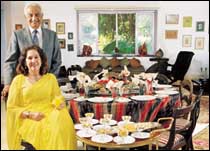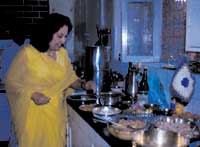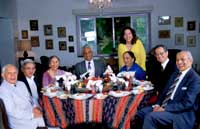


 cover story
cover storyDawat -e- Hyderabad Lunch with Air Marshal Idris and Begum Bilkis Latif |
|
What do air chief marshals do when they retire? The same that retired generals do - live in bungalows among the hills and tend to their gardens. That is what Air Chief Marshal Idris Latif, chief of the Indian Air Force, governor of Maharashtra, ambassador to France, and a dozen other things, does, at Road No. 1, Banjara Hill, Hyderabad. It is a modest but comfortable bungalow, with an upstairs and downstairs, connected by a wooden staircase, along which his grand children run up and down during their holidays, since in the modern buildings where they stay, there are high speed elevators and no staircases. I was in Hyderabad and Mrs. Bilkees Latif, who has recently written a very authoritative and thoroughly researched book on Hyderabadi and Andhra cooking (Penguins), invited me to lunch. "Would you prefer a Continental or Hyderabadi lunch?" she asked. I made the obvious choice. It was a table for eight, since eight is the number her table could hold, and the guests were chosen with as much care and deliberation as the menu. There was General Krishna Rao, former chief of staff, Indian Army, and twice governor of Jammu and Kashmir, and his wife Radha; there was Mir Mouzam Husain, who has worked in the Nizam's civil service and with UNESCO, and lived all over the world, and his wife Shezadi, and Anwar Ali Khan, O&M, Bombay, and presently on a sabbatical in Hyderabad. The invitation was 1 p.m., and Mrs. Latif had prepared the entire meal, assisted by Mohamed Uzair, her cook from Bihar, who was carefully being tutored into the subtleties of Hyderabadi cuisine. I was the first to arrive and the air chief marshal and I sat on the back porch, a tiny lotus pond to our left, the Latifs's pet quails pecking away at bits of grain at our feet. Soon we would be having their miniscule eggs, grilled and served as canapes on tiny Bibi Mariam Ki Rotis.
He is a photography buff, also movie camera, and has shot, developed and processed amateur movies. And, of course, there is gardening. He looks like a man contented, life's labours done. Mir Mouzam Husain and wife arrived on the dot. He wore a neat blue-stripes-on-white-background suit, the kind you would wear to formal luncheons in the tropics, a walking stick, silver hair neatly spread over the head. He appeared feeble, but spoke firmly and even energetically. As the afternoon advanced, he perked up more and more. There is a chapter on him in Dalrymple's book, and his wife's stories about the djinns. His begum was more traditionally dressed, her father was one of the great Urdu poets of the Nizam. She herself had written a book on a prince of Hyderabad who had a tragic end and did not become a Nizam. The Mir was also an author and had written an entire book in English verse on a son of Shah Jehan who did not succeed his father as the Mughal Emperor. A literary couple, though somewhat esoteric, and, as the lunch progressed, they showed some amazing down-to-earth qualities in their anecdotes.
Anwar Ali Khan came last, a familiar face, at last, he is related to the Latifs on both sides, Ali Yavar Jung's sister's grandson, and Akbar Hydri's great grand nephew. I mention the pedigree because these things are important in Hyderabad society, wherever I went the family tree was mentioned, all somehow linked with the Nizams, either through blood or service on his elite staff. Nobody drank. The air chief marshal is not much of a drinker, the general is, but only after sunset (like me), and, in any case, wine could not be served because they had given away all their wine glasses after returning from France. They had only champagne and sherry glasses, and, as Mrs. Latif pointed out: "Idris said you can't serve wine in champagne and sherry glasses." We had a passion fruit sherbet, the passion fruit from the air chief marshal's garden, and with lunch we had lassi in small glasses. First, the photographs, and everybody was quite impressed, what with the lights and the reflectors. "Very professional," was the unanimous comment. The general recalled he was being interviewed by NDTV in Srinagar when Home Minister Shankerrao Chavan (his bete noire) arrived. He asked his officers to look after the minister while he concluded the interview. Next day there was a scandal as newspapers carried the story: Governor ignores home minister while he poses for TV. There was a Lazy Susan on the table and food revolved around it as the faithful Uzair brought it in dish by dish. Not once in the 150-minute lunch did the hostess have to get up and go in the kitchen. That's what good hostessing is all about, don't appear hassled, prepare everything, then sit with your guests and participate, don't go rushing into the kitchen. We began with Luqmi, the original Muslim kheema samosa, but flat, not triangle. "Don't finish it all, leave half," the hostess said, graciously. Then the Bibi Mariam Ki Roti, with grilled liver, dill and cream cheese, and topped with a quail egg, hard-boiled. This is fusion cuisine, invented by the ambassador's wife, at the Indian embassy in Paris. "In Paris, we had a 21 sitting," Mrs. Latif said. "And three cooks from India for the flambes, coming in smoked from the oven." Finally, the first course, Haleem, Hyderabad's signature dish. And not because the Latifs are my favourite people, or the setting was right, this is the best Haleem I have eaten. The lamb meat and the wheat was throughly mashed into a velvety porridge, the onions, birishta, were fried crisp and crumbled in the mouth, the mint leaves were fresh and I did not mind their coming in the mouth (I normally do). Mir Mouzam's wife, no mean cook herself, put a little lamb korma on the Haleem, to further wet it. I did not think it was necessary. The Lagan Kababs, also known as Lagan Ka Kheema, arrived on the table in an aroma of smoked meat. The whole dish had been flambed, plus, a lighted piece of charcoal, wrapped in an onion skin, had been placed in a hole made in the middle of the meat, and the dish then covered, to spread the smokiness around. It looked like solid meat, nicely browned, but you could cut through it with a spoon. We had it with shreemal, a flat spongy bread, made with flour and eggs, milk and sugar. Mir Mouzam, whose old house, now used by the state engineering department, had been described as built on Versailles proportions, talked of the meals at the City Palace, where 400 people sat in a long hall and feasted, and from one end you could not recognise the man at the other end. Falaqnama, so lavishly furnished, was a little different, here the diners were not in such large numbers, but of a higher status. To continue with the lunch, Sufaid Murgh, made with cream and almonds, was followed by Tomato Kutt, a tomato gravy with hardboiled eggs. Mrs. Krishna Rao, who was the only vegetarian on the table, could at last share with us the same dish. The Krishna Raos live in a colony some distance out of Hyderabad. A nice place, he said, he had no complaints, but he would have been happier if he had managed a house in Delhi. Meanwhile, we moved on to Kachhe Gosht Ki Biryani, the most non-oily, or least oily, biryani in the world, made with dahi and caraway sdeeds and saffron-flavoured meat. The last dish was Mirchi Ka Salan, another signature dish. I picked the green chilli from the stem and bit into it, sesame seeds and all, the tamarind juice bursting in my mouth. The Hyderabadis present explained, they ate it at the end of the meal as a digestive. The tamarind is the digestive. But there was still dessert, coffee, and a sweet called Ashrafi, round like a coin and with the nizam's seal stamped on it. Begum Latif was serving them as if they were petits fours for Monsieur Mitterand. She also made it very clear to me, we do not dine like this every day, we have a soup and a salad, and may be a baked fish. |

Home Page
 The air chief marshal showed me albums of photographs he had taken over the years, patterns in the sand made by crabs on the Bombay Raj Bhavan beach, large stones balanced on one another, like in an open-air sculpture museum, that he had discovered a little outside Hyderabad, family pictures of his sons, daughter Mariam Sandhu (a facial bone structure that resembles the two Jacquelines, Kennedy and Bisset), grand children.
The air chief marshal showed me albums of photographs he had taken over the years, patterns in the sand made by crabs on the Bombay Raj Bhavan beach, large stones balanced on one another, like in an open-air sculpture museum, that he had discovered a little outside Hyderabad, family pictures of his sons, daughter Mariam Sandhu (a facial bone structure that resembles the two Jacquelines, Kennedy and Bisset), grand children.
 General Krishna Rao arrived with a jeep-full of security escort, the tragic burden of his days as Kashmir governor, no doubt. He is tall and athletic, a rangy young man who looks younger than some of his mouse-haired successors that I saw on TV during the Kargil war.
The general and the air chief marshal were at the NDA together in 1951, as instructors. The air chief marshal told me: "He is a good professional soldier." That, I suppose, is high praise, coming from one service chief to another.
General Krishna Rao arrived with a jeep-full of security escort, the tragic burden of his days as Kashmir governor, no doubt. He is tall and athletic, a rangy young man who looks younger than some of his mouse-haired successors that I saw on TV during the Kargil war.
The general and the air chief marshal were at the NDA together in 1951, as instructors. The air chief marshal told me: "He is a good professional soldier." That, I suppose, is high praise, coming from one service chief to another.